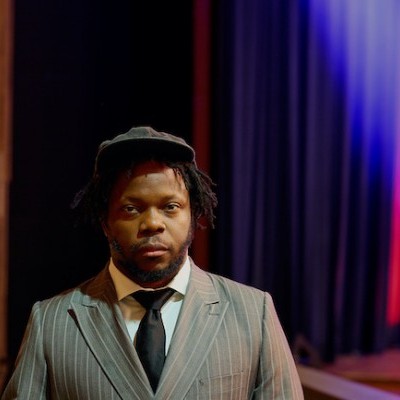Apr 2, 2024 12:59 PM
Saxophonist, Sonic Explorer Casey Benjamin Dies at 45
Casey Benjamin, the alto saxophonist, vocalist, keyboardist and producer who stamped his distinctive sounds on the…

Irabagon has simultaneously released two albums on his own label, Irabbagast Records.
(Photo: Stephanie Matthews)If ever there were an artist who has earned the label “enigma,” it would be saxophonist Jon Irabagon, whose hyper-genre career has warped repeatedly between the narrow straight ahead paths and wide-open free spaces of the larger jazz universe. How else to describe one who travels to South Dakota to improvise on wildlife mating calls in abandoned munitions bunkers, and who devotes an entire album to horrific techniques humans have developed throughout history to maim and murder each other?
Irabagon’s enigmatic antics continue with two simultaneous releases on his own label, Irabbagast Records, with Recharge The Blade, an intense-yet-spirited, mostly quintet album with the leader on soprano saxophone, assisted by trombonist Ray Anderson, pianist Matt Mitchell, bassist Chris Lightcap and drummer Dan Weiss; and Survivalism, a mostly free improv album for solo soprillo, the smallest and highest-pitched of the saxophone family. Irabagon’s penchant for introducing two albums at a time of drastically differing music hasn’t enamored him with critics. He recounts an experience from a previous dual release: “The reviewer said one of these records is one of the best that came out this year and one of these records is the worst … . I like that for some reason. That makes me feel my music is alive because the same person can love and hate me at the same time.”
Irabagon, rather engaging and jovial for an enigma, is a second-generation Filipino-American from Chicago who spent nearly two decades in New York before relocating back to his hometown. “I moved there about a week before September 11th happened, and I left during the pandemic — my New York stay was sandwiched by disasters,” he says over video from Chicago. While in New York, Irabagon exploded into public consciousness as the winner of the 2008 Thelonious Monk International Jazz Saxophone Competition (besting Walter Smith III and Tim Green among others), and again with the Moppa Elliott-led group Mostly Other People Do the Killing, which gained notoriety in 2014 for releasing Blue (Hot Cup), a note-for-note group transcription of Miles Davis’ iconic 1959 album Kind Of Blue (Columbia).
Winning the Monk Competition awarded Irabagon a one-record deal with Concord, that resulted in the well-crafted but conventional The Observer (2009). Yet he had already released two significantly different albums under his own name, including Jon Irabagon’s Outright! (Innova 2008), featuring a forward-leaning quintet with trumpeter Russ Johnson and pianist Kris Davis. It became an album concept perpetuated by Irabagon in later iterations, with Recharge The Blade completing (for now) the trilogy he had envisioned.
“Several things happen throughout all three of the Outright! trilogy records,” Irabagon explains. “They’re all me on a different instrument [for each album], paying homage in a way compositionally to all the giants that I love on those three individual instruments [alto, tenor, soprano].” For Recharge, Steve Lacy, Roscoe Mitchell, John Coltrane, Wayne Shorter and even Sidney Bechet loom in the backdrop of Irabagon’s writing and playing. Another carry-over is to have a “shredding guitar solo” on one of the pieces, done eloquently by Ben Monder on “Quorum Call.”
Irabagon reveals another tidbit: “Each of the albums has a tune that’s dedicated to a villain I love that I’m just fascinated by.” The latest antagonist came from the Marvel television series Jessica Jones, a show he got hooked on during the COVID lockdown. “Man, Kilgrave, he was super cool to me because he could control people’s minds to get them to do whatever [he wanted],” he gushes. His “Kilgrave” is completely improvised, save for the piano part, which is through-composed and entirely written out, casting pianist Matt Michell as the master mind-controller.
In addition to Jessica Jones, Irabagon binged The Sopranos and read novels during the lockdown. “I don’t think I was depressed,” he offers unconvincingly. “It’s just at some point, reading Cormac McCarthy, watching a mob series, and with all the COVID stuff going on, I realized humans are the best at destroying themselves.”
He started becoming obsessed with the notion. “Maybe, I was depressed because I did a ton of research on that stuff … . I kept trying to talk to my wife, like, did you know that they used to drag bodies underneath ships? She was like, we need to watch some comedy.” Nevertheless, Irabagon channeled his morbid fascination into the music, themes and titles for Recharge The Blade.
Irabagon was finally able to get some fresh air when they relocated for a time during the pandemic to South Dakota, to get away from New York, closer to his wife’s family. He spent many hours in the woods, practicing saxophone [and recording it]. At some point, he ventured away from the forest to the town of Igloo, where more than 800 abandoned bunkers are located, originally built by the U.S. Government to house munitions. The lands are now used for cattle grazing, but many are or will be repurposed into luxury survival bunkers, catering to those who have literally bought into Irabagon’s dark vision of humanity.
But the upside is that those bunkers have amazing reverb. Irabagon realized that the sound was ideal for his next solo project for soprillo saxophone, a tiny instrument about the size of a travel mug, one octave higher than a soprano. Two years later, Irabagon returned to the bunkers, armed only with his soprillo and a bunch of wild-game calls used for hunting.
The resultant album, Survivalist, is an exercise in novelty and — possibly for the listener — courageous endurance. Irabagon experimented with placing his game calls before, beneath and between the parts of his tiny saxophone. One no longer needs to imagine what the dying screams of a young, semi-large mammal being butchered alive might sound like. The killing sounds are gorgeously captured by the recording, enhanced by the bunker’s luscious reverb. “The reverb acted as a duet partner,” he remembers. “It definitely affected how I played. It definitely changed all the plans I was making and prepping for the record.”
One change was to include two standards: Thelonious Monk’s “Reflections” and Charles Mingus’ “Duke Ellington’s Sound Of Love.” Their presence serves to highlight Irabagon’s struggle to achieve technical and timbral control from a difficult instrument, to ultimately produce what sounds like beauty, if only — as Monk might posit — ugly beauty.
Irabagon readily admits to an irreverent, if not absurdist, attitude toward life and its symbolic counterpart, art. “I’ve always been a prankster and a jokester,” he says. “I love being serious enough that you can have fun with something because you invested so much seriousness into it, and I love the humor aspect of the music that Charlie Parker and Sonny Rollins brought to the table decades ago.” Irabagon’s own absurd humor marches briskly during the last track of Recharge, “Welcome Parade,” a tribute to the undisputed best (selling) soprano saxophonist, Kenneth Gorelick, beginning as a faithful facsimile before devolving into a howling wall of sound from more than 100 musicians who sent Irabagon audio for the track.
“Life means you’re [getting] pretty dark pretty fast, and pretty depressing really fast, and so absurdism is something where you can laugh, you can see what a crazy situation we’re in here,” he offers. “I think being able to face that and admit what’s happening is definitely a part of where I come from musically and personally.
“Being able to play music and being able to feel free enough to express my musical angle and my philosophies through the music — it’s been a life saver.”
Along with a bit of gallows humor. DB

Benjamin possessed a fluid, round sound on the alto saxophone, and he was often most recognizable by the layers of electronic effects that he put onto the instrument.
Apr 2, 2024 12:59 PM
Casey Benjamin, the alto saxophonist, vocalist, keyboardist and producer who stamped his distinctive sounds on the…

Albert “Tootie” Heath (1935–2024) followed in the tradition of drummer Kenny Clarke, his idol.
Apr 5, 2024 10:28 AM
Albert “Tootie” Heath, a drummer of impeccable taste and time who was the youngest of three jazz-legend brothers…

“Both of us are quite grounded in the craft, the tradition and the harmonic sense,” Rosenwinkel said of his experience playing with Allen. “Yet I felt we shared something mystical as well.”
Mar 12, 2024 11:42 AM
“There are a few musicians you hear where, as somebody once said, the molecules in the room change. Geri was one of…

Henry Threadgill performs with Zooid at Big Ears in Knoxville, Tennessee.
Apr 9, 2024 11:30 AM
Big Ears, the annual four-day music celebration that first took place in 2009 in Knoxville, Tennessee, could well be…

“I’m also at a point in my life where I don’t feel like I have anything to prove, like at all,” Akinmusire says about his art.
Mar 26, 2024 12:45 PM
At the risk of oversimplifying and romanticizing the story, Ambrose Akinmusire came bursting on the jazz scene at the…